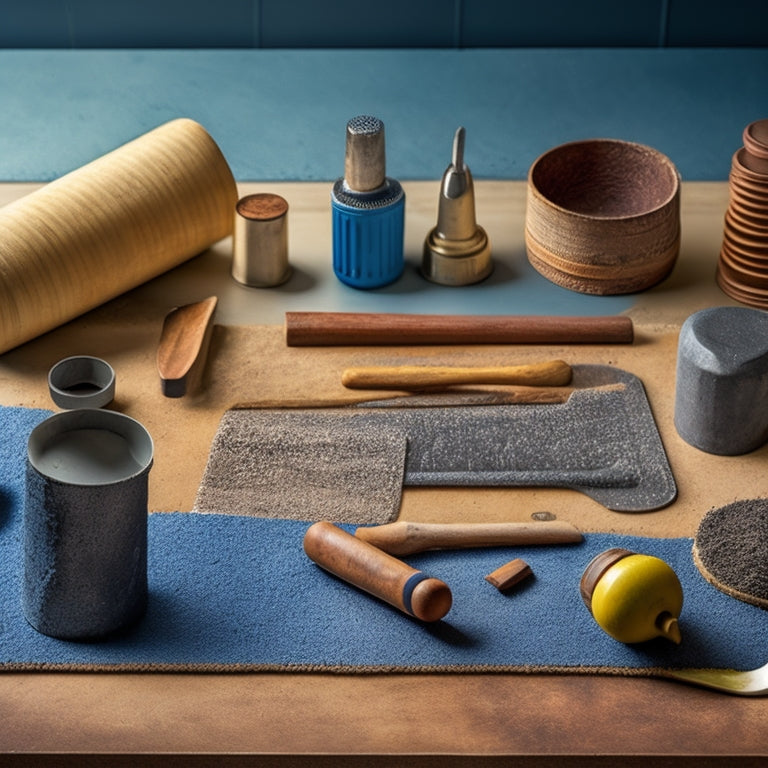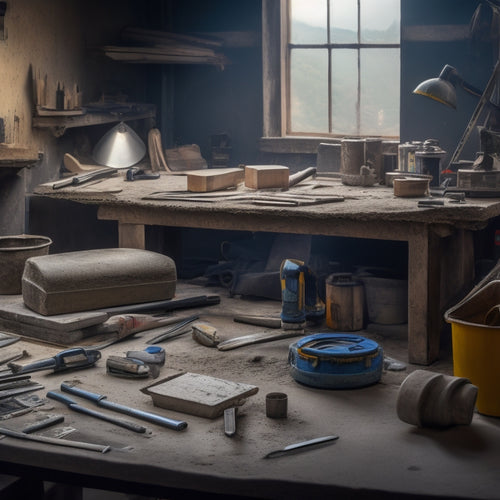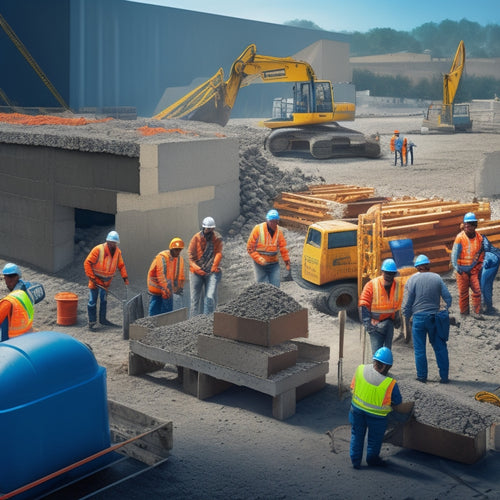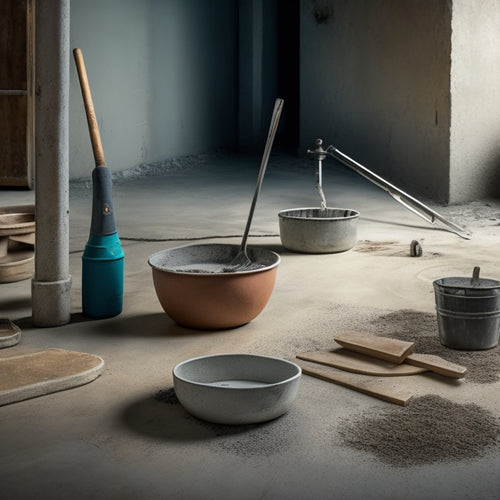
Top 5 Must-Have Tools for Concrete Stamping
Share
You'll need a combination of essential tools to achieve a professional-looking concrete stamping finish. Start with a high-quality stamping mat and a suitable tamper, such as a hand tamper or bull float, to guarantee precise control and efficient compaction. A specialized edger, like a radius or masonry edger, is also vital for clean lines and defined patterns. Don't forget a reliable sealant application tool, such as a sprayer or roller, and a finishing touch texture tool, like a texture mat or skin, to achieve realistic patterns. With these top 5 must-have tools, you'll be well-equipped to tackle your project, and as you explore their uses and techniques, you'll reveal the secrets to exceptional results.
Key Takeaways
• A high-quality sprayer or roller is essential for even sealant application and a smooth finish in concrete stamping projects.
• A hand tamper or bull float is necessary for achieving the right level of compaction and texture in stamped concrete.
• A concrete edger, such as a radius edger or masonry edger, is required for creating clean lines and defined patterns in stamped concrete.
• Texture mats or skins are must-have tools for creating realistic, textured finishes in concrete stamping, such as natural stone or wood grain patterns.
• A tamping rake or power tamper is crucial for achieving the right level of traction and texture in high-traffic areas or large, busy spaces.
Stamping Mat Pattern Selection
What pattern will you choose to achieve the desired aesthetic and functional requirements of your concrete stamping project? The selection of a stamping mat pattern is essential in determining the overall look and feel of your finished concrete surface.
With numerous pattern designs available, you'll want to take into account the texture variety that best suits your project's needs. Will you opt for a natural stone pattern, such as a slate or flagstone design, or perhaps a more modern, geometric pattern like a herringbone or hexagon?
The choice of pattern won't only influence the visual appeal of your project but also its functionality. For instance, a textured pattern can provide improved traction, making it ideal for high-traffic areas or outdoor spaces.
On the other hand, a smooth pattern may be more suitable for interior applications where a sleek, modern look is desired. By carefully evaluating the pattern design and texture variety, you'll be able to achieve a concrete surface that meets both your aesthetic and functional requirements.
Essential Tamping Tool Options
With your stamping mat pattern selected, you'll need to confirm the concrete is properly compacted to achieve a uniform impression, and that's where the right tamping tool comes in. A good tamping tool helps you achieve a dense, even surface, guaranteeing your stamp pattern turns out as intended.
When choosing a tamping tool, consider the following essential options:
| Tamping Tool Type | Description |
|---|---|
| Hand Tamper | Ideal for small areas, providing precise control and flexibility |
| Bull Float | Suitable for larger areas, offering efficient compaction and leveling |
| Tamping Rake | Combines tamping and raking functions, perfect for textured finishes |
| Power Tamper | High-speed compaction for large, high-traffic areas |
| Pneumatic Tamper | Air-powered tool for fast, efficient compaction |
To get the most out of your tamping tool, remember these tamping technique tips: maintain a consistent pace, apply even pressure, and avoid over-tamping. Regular tamping tool maintenance is also vital to guarantee peak performance. Clean your tool after each use, and perform routine inspections to prevent damage. By selecting the right tamping tool and following best practices, you'll achieve professional-looking results with your concrete stamping project.
Must-Have Sealant Application Tools
Your sealant application toolset should include a high-quality sprayer or roller, a precision brush, and a microfiber cloth to guarantee a flawless, even sealant coat. These tools will help you achieve a professional finish, regardless of the sealant type you're working with.
When it comes to application techniques, you'll need to take into account the specific requirements of your sealant. For example, some sealants are better suited to being sprayed, while others are best applied with a roller. Having the right tool for the job ensures a smooth, even coat that won't leave behind streaks or bubbles.
With a precision brush, you'll be able to get into tight spaces and corners, where a sprayer or roller might struggle to reach. Meanwhile, a microfiber cloth is perfect for wiping away excess sealant or cleaning up spills.
Concrete Stamping Edger Needs
You'll require a set of specialized edging tools to create crisp, clean lines and defined patterns in your concrete stamping project. These edgers come in various types, each designed for specific tasks.
For instance, a radius edger is ideal for curved edges, while a masonry edger is perfect for creating sharp, 90-degree angles. You may also need a detail edger for intricate designs and a texture edger for adding texture to your concrete.
When selecting edgers, consider the type of project you're working on and the specific edges you need to create. It's vital to choose the right edger for the job to achieve professional-looking results.
Additionally, proper edger maintenance is important to extend the tool's lifespan and guarantee peak performance. Regularly clean and lubricate your edgers, and store them in a dry place to prevent rust.
Finishing Touch Texture Tools
Achieving a realistic, textured finish in your concrete stamping project requires the right finishing touch texture tools, which add depth and visual interest to your design.
You'll want to choose tools that allow you to achieve the desired texture application techniques. For example, you can use texture mats or skins to create a natural stone or wood grain pattern. These tools are typically made from durable, flexible materials like polyurethane or silicone, which conform to the concrete surface.
When selecting finishing tool materials, consider the level of detail and texture you want to achieve. Some tools, like texture combs, are designed for more subtle, nuanced textures, while others, like stamp wheels, can create bold, dramatic patterns.
You may also want to experiment with different texture application techniques, such as layering or blending, to create a unique, one-of-a-kind finish.
With the right finishing touch texture tools and a little practice, you'll be able to achieve a stunning, professional-looking finish that will elevate your concrete stamping project to the next level.
Frequently Asked Questions
Can I Use Concrete Stamping Tools With Epoxy or Polyurethane Coatings?
When working with epoxy or polyurethane coatings, you'll need to guarantee compatibility before using concrete stamping tools, as some tools may not be suitable for epoxy application or may react with polyurethane, affecting the final result.
How Do I Clean and Maintain My Concrete Stamping Tools?
You'll extend the life of your concrete stamping tools by implementing proper tool storage and mastering cleaning techniques, such as gentle scrubbing and solvent-free degreasers, to prevent damage and maintain their performance.
Are Concrete Stamping Tools Suitable for Indoor or Outdoor Projects?
You're wondering if your trusty concrete stamping tools can handle both indoor elegance and outdoor ruggedness? The answer is yes, but it depends on the tool's material and design, which can guarantee indoor applications look flawless and outdoor durability stands the test of time.
Can I Rent Concrete Stamping Tools or Must I Buy Them?
You can explore renting options for concrete stamping tools, but consider buying if you plan frequent use or have specific needs, weighing buying considerations like quality, cost, and storage against rental convenience.
Are There Any Safety Precautions I Should Take When Using Concrete Stamping Tools?
When working with concrete stamping tools, you'll want to prioritize safety by wearing proper safety gear, including gloves, safety glasses, and a dust mask, and exercise caution in tool handling to avoid accidents and injuries.
Conclusion
You've got the basics down, now it's time to put the finishing touches on your concrete stamping project.
With these top 5 must-have tools in your arsenal, you'll be well on your way to creating a stunning, one-of-a-kind design that's sure to turn heads.
Remember, the devil is in the details, so don't cut corners – invest in the right tools and you'll be stamping like a pro in no time.
The result will be a masterpiece that's truly the icing on the cake.
Related Posts
-

3 Best Hand Tools for DIY Concrete Construction
When tackling a DIY concrete construction project, you'll need three essential hand tools to achieve a professional-l...
-

7 Best Tools for Concrete Block Construction
You'll need a solid foundation, precise cutting, and seamless finishing to guarantee your concrete block construction...
-

Why You Need These Concrete Overlay Tools
When tackling a concrete overlay project, you need the right tools to achieve a flawless finish and avoid costly mist...


